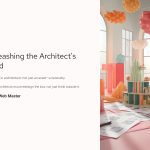 In an era where architectural trends are rapidly evolving, creativity is no longer just an asset—it’s a necessity. With the rise of parametric design, AI-assisted architecture tools, and eco-conscious planning, architects are expected to not only think outside the box but redesign the box itself. Enhancing creative thinking isn’t about random inspiration; it’s a skill that can be trained, structured, and systematically improved. This post dives deep into modern strategies that help architects sharpen their imaginative abilities, from psychological techniques to digital tools that fuel innovation. We explore how continuous creative training can lead to more sustainable, client-centric, and visually compelling outcomes that stand out in a competitive market.
In an era where architectural trends are rapidly evolving, creativity is no longer just an asset—it’s a necessity. With the rise of parametric design, AI-assisted architecture tools, and eco-conscious planning, architects are expected to not only think outside the box but redesign the box itself. Enhancing creative thinking isn’t about random inspiration; it’s a skill that can be trained, structured, and systematically improved. This post dives deep into modern strategies that help architects sharpen their imaginative abilities, from psychological techniques to digital tools that fuel innovation. We explore how continuous creative training can lead to more sustainable, client-centric, and visually compelling outcomes that stand out in a competitive market.

Understanding the Role of Creativity in Modern Architecture
Creativity in architecture is not just about aesthetics—it’s about solving problems in innovative ways. As urban environments become more complex and client demands evolve, architects must develop the ability to conceptualize adaptive, functional, and emotionally resonant spaces. Creativity becomes the bridge between technical feasibility and artistic expression, allowing professionals to propose original yet buildable solutions. It’s also crucial in competitions, where uniqueness and concept strength often determine the winner. Cultivating creativity means tapping into a mindset that blends logic with lateral thinking and embracing ambiguity as a path to discovery.

Rewiring the Brain: Neuroscience of Architectural Imagination
Creativity training starts in the brain. Neuroscience reveals that divergent thinking—key to innovation—activates different neural pathways than analytical reasoning. For architects, exercises like mind mapping, sketchstorming, or switching mediums (e.g., sculpting instead of sketching) help access less-used parts of the brain, promoting unique thought patterns. Regularly engaging in these tasks builds “cognitive flexibility,” enabling one to approach the same design brief in multiple ways. Also, taking part in architectural critique groups or idea jams can help build a more resilient creative mindset, encouraging risk-taking and experimentation without fear of failure.

Creative Habits and Routines That Actually Work
Habits shape creativity more than sudden bursts of inspiration. Famous architects like Zaha Hadid and Frank Gehry cultivated structured rituals that encouraged daily exploration and reflection. Setting aside dedicated ‘non-goal’ creative time—like free sketching or model-building with no client in mind—keeps the mind limber. Another useful method is the “design diary,” where architects jot down thoughts, details from dream architecture, or unusual spatial observations. This process creates a feedback loop between subconscious creativity and conscious development, making ideation second nature over time.

Tools and Tech That Expand Architectural Thinking
Modern tools have significantly changed the game for how architects think creatively. Parametric design platforms like Grasshopper allow for form-generation beyond manual capability. AI-driven platforms like Midjourney and DALL·E let architects visualize conceptual atmospheres or material ideas in seconds. VR tools help test spatiality before committing to builds, making abstract ideas tangible. By learning to “speak the language” of these tools creatively, architects aren’t just using technology—they’re co-creating with it, opening up a whole new dimension of design thinking and ideation.

Exercises to Train Visual Literacy and Spatial Thinking
Visual literacy is key for translating imagination into architecture. Daily sketching from memory, blind contour drawing, and visual analogy creation are just a few exercises that help. Another is the “space reinterpretation drill”—taking an existing space and redesigning it under different constraints (e.g., making a library work as a coworking café). Practicing such exercises not only improves one’s design agility but also helps in client communication. Enhanced visual literacy leads to better mood boards, presentations, and eventually, greater project approval rates.

Long-Term Impact: How Creativity Training Elevates Your Architectural Career
Committing to creativity training doesn’t just improve design—it changes the trajectory of your career. Architects who showcase originality and adaptability in their portfolios attract higher-end clients, are invited to more competitions, and often land editorial coverage in design architect creative trainingmagazines. Beyond reputation, there’s also a tangible financial benefit: firms led by innovative architects report higher client retention and project satisfaction. Over time, consistently creative professionals position themselves as thought leaders in the field, influencing trends rather than reacting to them.
*Capturing unauthorized images is prohibited*




